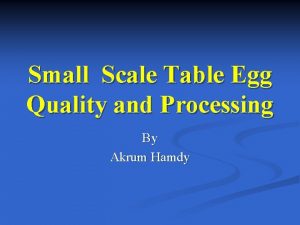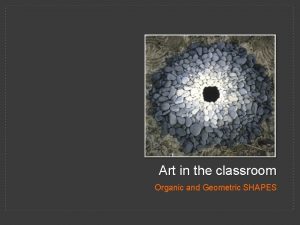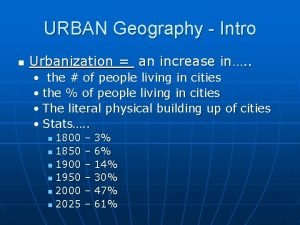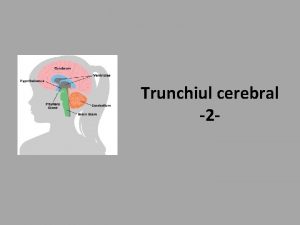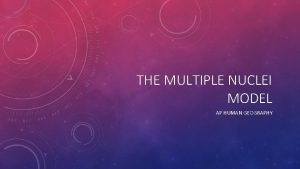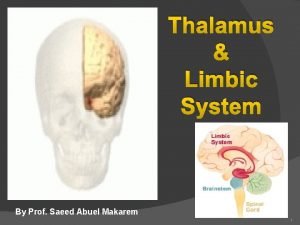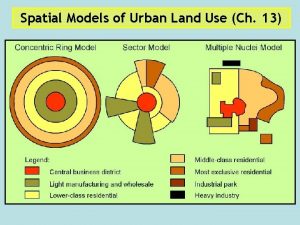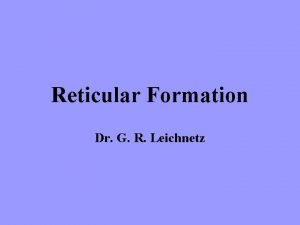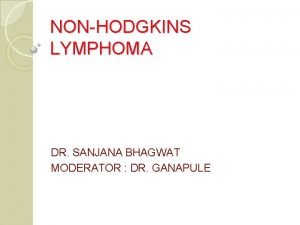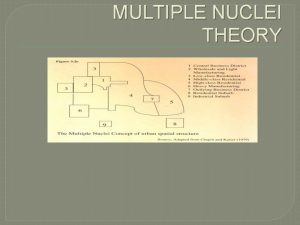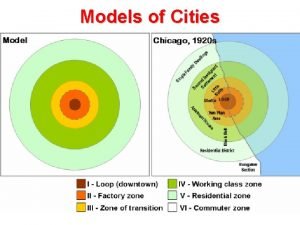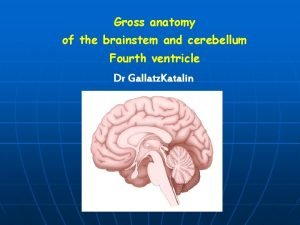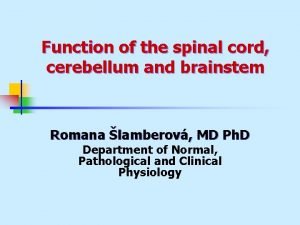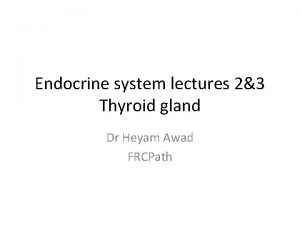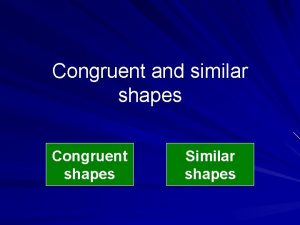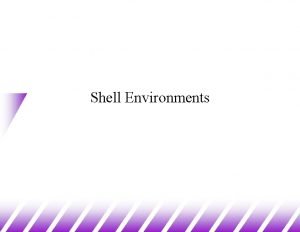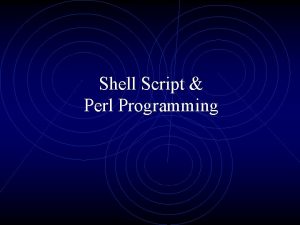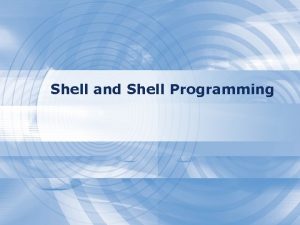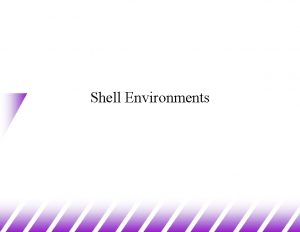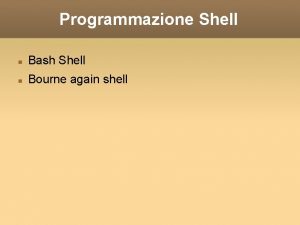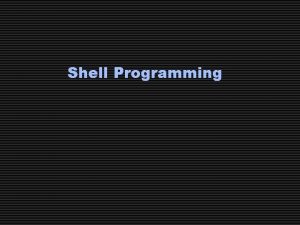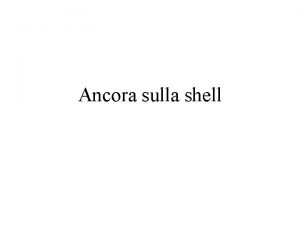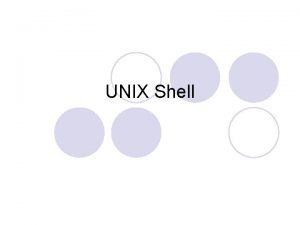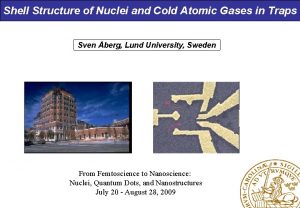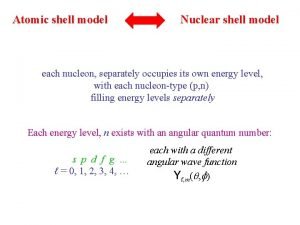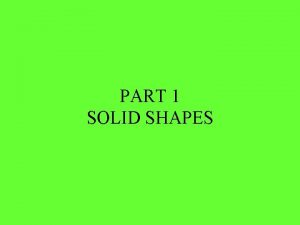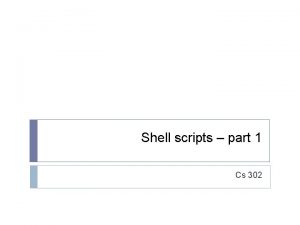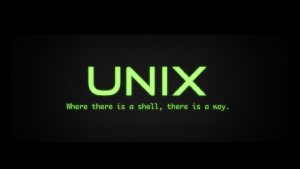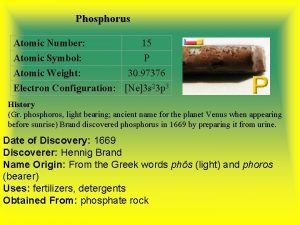Shell effects in atomic nuclei Part 2 shapes



![Nuclear structure description framework [Addendum to yesterday’s lecture] 1 - Shell-model: • nucleus described Nuclear structure description framework [Addendum to yesterday’s lecture] 1 - Shell-model: • nucleus described](https://slidetodoc.com/presentation_image_h/8617c9b7f9330e87be52d725a98bc89d/image-4.jpg)

































- Slides: 37

Shell effects in atomic nuclei Part 2: shapes and superheavy elements Laurent Gaudefroy 1, Alexandre Obertelli 2 1 CEA DAM, DIF, France 2 CEA Saclay, IRFU, France

Changes in the nuclear shell structure 126 Lecture (part 1) given by Laurent Gaudefroy protons 82 50 28 82 20 50 8 2 2 8 28 neutrons 20

Shapes of atomic nuclei Z, N = magic numbers protons 50 28 Nilsson diagram 82 28 20 82 20 50 8 2 50 sngle particle enegies Closed shell = spherical shape 126 20 28 neutrons 2 8 The vast majority of all nuclei shows a non-spherical mass distribution 8 Spherical Oblate 2 Prolate Deformed elongation
![Nuclear structure description framework Addendum to yesterdays lecture 1 Shellmodel nucleus described Nuclear structure description framework [Addendum to yesterday’s lecture] 1 - Shell-model: • nucleus described](https://slidetodoc.com/presentation_image_h/8617c9b7f9330e87be52d725a98bc89d/image-4.jpg)
Nuclear structure description framework [Addendum to yesterday’s lecture] 1 - Shell-model: • nucleus described in the laboratory frame • the nucleus is described as a superposition of spherical configurations • « intrinsic deformation » is implicitely contained in correlations 2 - Mean-field like description: • nucleus described in its intrinsic frame • « angular momentum » is not a good quantum number • intrinsic deformation is explicit In this lecture, the deformed mean-field approach will be followed

Nilsson diagram K =7/2 K =5/2 K =3/2 - nlj=1 f 7/2 0 • core + single particle • short range & attractive int. • Pauli : orbit repulsion K =1/2 -

Shapes and “deformation” parameters Generic nuclear shapes can be described by a development of spherical harmonics alm: deformation parameters quadrupole Tetrahedral Y 32 deformation Triaxial Y 22 deformation octupole Lund convention oblate non-collective spherical hexadecapole Static rotation 2 : elongation : triaxiality prolate non-collective prolate collective oblate collective Dynamic vibration

Shapes and “deformation” from experiment Ø Quadrupole moments via low-energy Coulomb excitation Reorientation effect target quadrupole projectile excitation * Coulomb field photon de-excitation Intrinsic quadrupole moment ØMoment of inertia via rotational-band spectroscopy / model dependent J =8+ J =6+ J =4+ J =2+ J =0+ even-even

Quadrupole deformation of nuclei N=Z Oblate Pb & Bi actinides N~Z Fission fragments N~28 n-rich Prolate M. Girod, CEA Oblate deformed nuclei are far less abundant than prolate nuclei Shape coexistence possible for certain regions of N & Z

Shape coexistence M. Girod M. Bender et al. , PRC 74, 024312 (2006) 74 Kr oblate 6+ 4+ 6+ 2+ 4+ 0+ prolate 8+ 2+ 0+ Configuration mixing: electric monopole (E 0) transition

Shape coexistence in light Krypton isotopes 6+ 8+ 4+ 6+ 2+ 4+ 0+ 2+ 0+

Shape coexistence in light Krypton isotopes Coulomb excitation of 74, 76 Kr 78 Kr source 74 Kr 4. 7 Me. V/u 104 pps CSS 1 CSS 2 78 Kr 68. 5 Me. V/u 1012 pps SPIRAL beams 76 Kr 5 105 pps 74 Kr 104 pps 4. 7 Me. V/u SPIRAL ECRIS target CIME [24°, 55°] 74 Kr [55°, 74°] [67°, 97°] [97°, 145°]

Shape coexistence in light Krypton isotopes Quadrupole moments first reorientation measurement with radioactive beam SPIRAL 1, GANIL (France), 2005 Fit matrix elements (transitional and diagonal) to reproduce experimental -ray yields (as function of ) Ø 14 B(E 2) values Ø 5 quadrupole moments E. Clément et al. , PRC 75, 054313 (2007)

Comparison with ‘beyond-mean-field’ theory prolate oblate Qs<0 prolate GCM calculation axial deformation Skyrme SLy 6 M. Bender et al. PRC 74, 024312 (2006) Qs>0 oblate experimental B(E 2; ) [e 2 fm 4] E. Clément et al. , PRC 75, 054313 (2007) prolate oblate K=2 vibration GCM (GOA) calculation q 0, q 2: triaxial deformation Gogny D 1 S M. Girod et al.

Extreme shapes and intruder orbitals 152 Dy 108 Cd single-particle energy (Woods-Saxon) i 13/2235 U N+3 shell N+2 shell N+1 shell N shell Z=48 Energy Fermi level Deformation ND SD quadrupole deformation HD Ø (N+1) intruder normal deformed, e. g. 235 U Ø (N+2) super-intruder Superdeformation, e. g. 152 Dy, 80 Zr Ø (N+3) hyper-intruder Hyperdeformation in 108 Cd, ?

The quest for high-spin superdeformation: 152 Dy TESSA 3 (12 detectors), Daresbury (UK) P. Twin et al. , Phys. Rev. Lett. 57, 811 (1986) Ø first discrete superdeformed band Ø energy spacing: E = 47 ke. V TESSA Ge array Extracted moment of inertia 8+ 6+ 4+ 2+ 0+ even-even

The quest for high-spin superdeformation: 152 Dy Properties of the superdeformed band firmly established 20 years later Argonne National Lab. Gammasphere 108 Ge detectors T. Lauritsen et al. , Phys. Rev. Lett. 88, 042501 (2002)

Pushing the limits: The quest for nuclear hyperdeformation Hyperdeformation favored at high-spin Competition with fission Need for intense neutron-rich beams Spiral 2 : intense Kr and Sn neutron-rich beams Fission barrier vs. High spin n-rich beam stable beam

The AGATA germanium array New generation gamma-detection array based on the tracking method > Efficiency ~ 40 % Huge gain in γγ, γγγ, … efficiency > Cristal rate up to 50 k. Hz Allow larger beam intensity • 180 large volume 36 -fold segmented Ge crystals in 60 triple-clusters • Digital electronics and sophisticated signal processing algorithms (PSA) • Operation of Ge detectors in position sensitive mode -ray tracking http: //www-w 2 k. gsi. de/agata/

Existence and structure of heavy elements Limits of stability ? Shell structure ? Next magic number ? 238 U ~4. 5 109 y 208 Pb Chart from http: //www. nndc. bnl. gov/chart/

Synthesis of heavy elements in the universe Why SHE do not exist on earth ? 1 - not stable 2 - not formed during the r-process B. Pfeiffer et al. , NPA (2001) Cassiopea A supernova

Upper limit of stability : positron emission Nuclei for Z larger than 173 become unstable against positron emission. The most deeply bound electrons from the 1 s 1/2 shell reach an energy of -511 ke. V W. Pieper, W. Greiner Z. Phys. A 218 (1968) 327 J. Reinhardt et al, Z. Phys. A 303 (1981) 173

Limits of stability : fission Surface prefers spherical nuclei Coulomb favours deformation If BE(ε) -BE(ε=0)> 0: gain in energy with deformation fission • B(A, Z) = av A - as A 2/3 - ac Z 2/A 1/3 - aa (A-2 Z)2/A +δ A-1/3 volume – nuclear attractive force less binding at the surface Coulomb – proton repulsion asymmetry pairing b R V= 4/3 R 3 S=4 R 2 a a=R(1+ ) b=R(1+ )-1/2 V=4/3 ab 2 S=4 R 2(1+2/5 2+…)

Liquid drop energy (Me. V/A) Fission barrier – liquid drop Deformation β

Limits of stability from liquid drop model Stability = balance between surface and coulomb • Fissility parameter x = Ecoulomb/ 2 Esurface • • • ~ 1/50 Z 2 / A scaling of the fission barrier x > 0. 8 : no survival • Possible definitions of SHE : No macroscopic fission barrier Bf < 1 Me. V x > 0. 8

State of the art Superheavy elements synthesized in laboratory Shell effects balance fission and are responsible for the existence of superheavies! Superheavy elements Z 104

Chemist point of view H 1 Li Be 3 4 Na Mg 11 K 19 12 Point of view of chemist : Actinides 90 Z 103 Transactinides 104 Z 121 (? ) Arbitrary point of view : Superheavies: existence due to shell effects Ca Sc Ti 20 22 Rb Sr 21 23 2 B C 5 6 Al Si 13 14 N 7 P 15 O 8 S 16 F Ne 9 10 Cl Ar 17 18 Cr Mn Fe Co Ni Cu Zn Ga Ge As Se Br Kr 24 36 25 26 27 28 29 30 31 32 33 34 35 Zr Nb Mo Tc Ru Rh Pd Ag Cd In Sn Sb Te 40 41 42 43 49 50 Cs Ba La Hf Ta W Re Os Pt Au Hg Tl Pb Bi Po At Rn 55 72 73 74 75 78 81 82 37 38 56 Y V He 39 57 44 76 45 Ir 77 46 47 79 48 80 51 83 52 84 I 53 85 Xe 54 86 Fr Ra Ac Rf Db Sg Bh Hs Mt Ds Rg 112 113 114 115 116 117 118 87 88 89 104 105 106 107 108 109 110 111 119 120 96 004 9 2 1 10 007 0 2 2 Cn (2010) copernicium Lanthanides Ce Pr Nd Pm Sm Eu Gd Tb Dy Ho Er Tm Yb Lu Actinides Th Pa 58 90 59 91 60 U 92 61 62 63 64 65 66 67 68 69 70 71 Np Pu Am Cm Bk Cf Es Fm Md No Lr 93 94 95 96 97 98 99 100 101 102 103

Peninsula vs island of stability Spherical 298114 238 U ~4. 5 109 y Deformed 254 No, 270 Hs LDM 152 LDM 162 LDM 184 LDM

Modern-theory predictions Z N W. S 114 184 HFB 126 184 RMF 120 172 M. Bender et al. PL B 515 (2001) 42 Note 1 : Up to 208 Pb : proton and neutron magic numbers identical. Note 2 : Models rely on extrapolations –parameters are adjusted on known cases

Level density increases with A, Z 132 Sn : Large gap Super-heavies : Gap function of models and not marked M. Bender et al. , Phys. Lett. B 515 (2001) 42 Theoretical challenges

Why is it so difficult to get information on SHE? 1 second times needed to observe on 1 minute average 1 event 1 hour present sensitivity: 1 day 10 days limit 1 pbarn beam dose: 1. 5 1018 projectiles

Synthesis and Identification of SHE n 70 Zn 208 Pb 277112 273110 269 Hs 265 Sg known kinematic separation in flight 257 No 253 Fm 8. 34 Me. V 15. 0 s Date: 09 -Feb-1996 Time: 22: 37 h 261 Rf 8. 52 Me. V 4. 7 s CN 11. 45 Me. V 280 s 11. 08 Me. V 110 s 9. 23 Me. V 19. 7 s 4. 60 Me. V (escape) 7. 4 s identification by - correlations to known nuclides

State-of-the-art worldwhile RIKEN Tokyo, Japan GSI JINR/FLNR Dubna, Russia 294118: Yu. Oganessian et 294117: Yu. Oganessian et al. , J. Phys. G R 165 (2007) al. , Phys. Rev. Lett. 104, 142502 (2010)

Spectroscopy of Transfermium elements (courtesy of P. -H. Hennen) Access to high j deformed orbitals : probe of higher lying spherical orbitals Prompt and/or decay spectroscopy R. -D. Herzberg et al. , Nature 442, 896 -899 (2006) S. K. Tandel et al. , PRL 97, 082502 (2006)

Bridging the gap from heavies to superheavies 253, 254, 255 No mass measurement Cyclotron resonance curve of 253 No 2. M Block et al. , Nature 463, 785 -788 (2010)

The S 3 spectrometer at SPIRAL 2 A spectrometer for the high intensity stable ion beams of SPIRAL 2 (from 2012) New elements 54 Cr+248 Cm 299120+3 n S 3 (I=10 pµA) 1 evt/month@σest~0. 01 pb ? Isotopic exploration 40 -48 Ca+238 U 275 -283112+3, 4 n S 3 (I=20 pµA) 40 evt/week/pb Closed-shell deformed nucleus ? ? ? 40 Ar+238 U 274 Ds (+4 n) 270 Hs + α S 3 (I=50 pµA) 190 evt/week@σth=2 pb

Summary Ø most nuclei are deformed Ø prolate quadrupole deformation are the most common Øshape coexistence: interplay between shell effects and macroscopic properties Øessential to constrain collective nuclear models Ø Very large deformations encoutered at high spin Ø superdeformation evidenced / hyperdeformation still to be discovered Ø AGATA high-resolution germanium array Ø superheavy elements exist only because of shell effects Ø theory predicts deformed + spherical shell gaps Ø next proton magic number still to be discovered Ø very low production cross sections Ø direct production and undirect experimental techniques Ø SPIRAL 2 and S 3 spectrometer

Key questions and shell effects in nuclei • How does shell structure evolve away from stability? magic numbers, shell-model, spin-orbit, tensor • How do nuclear clusters and molecules form? few-body systems, halos, clusters • What is the shape of a nucleus, how large can be nuclear deformation? hyperdeformation, shape-coexistence • Is there any island of stability for superheavy elements? Next proton magic number, stabilizing deformed shell gaps • Next-generation facilities and innovative detectors worldwhile built this decade
 Shell cleanliness shell soundness shell
Shell cleanliness shell soundness shell Ropey strands of egg white
Ropey strands of egg white Atomic nuclei
Atomic nuclei Shapes that seem to follow no rules.
Shapes that seem to follow no rules. Is atomic mass and relative atomic mass the same
Is atomic mass and relative atomic mass the same Trends in periodic table
Trends in periodic table Atom size periodic table
Atom size periodic table Difference between atomic mass and mass number
Difference between atomic mass and mass number Whats the difference between atomic mass and atomic number
Whats the difference between atomic mass and atomic number Atomic number vs atomic radius
Atomic number vs atomic radius Part whole model subtraction
Part whole model subtraction Unit ratio definition
Unit ratio definition Part part whole
Part part whole Part by part technical description example
Part by part technical description example Bar layout equipment
Bar layout equipment The phase of the moon you see depends on ______.
The phase of the moon you see depends on ______. Minitab adalah
Minitab adalah Sub saharan african city model
Sub saharan african city model Multiple nuclei model example
Multiple nuclei model example Sprawl geography definition
Sprawl geography definition Bid rent theory
Bid rent theory Trunchiul cerebral
Trunchiul cerebral Sector model ap human geography
Sector model ap human geography Multiple nuclei model ap human geography
Multiple nuclei model ap human geography Function of the thalamus
Function of the thalamus Hoyts sector model
Hoyts sector model Reticular formation
Reticular formation Follicular nonhodgkins lymphoma
Follicular nonhodgkins lymphoma Harris ullman multiple nuclei model
Harris ullman multiple nuclei model Concetric zone model
Concetric zone model Burgess model assumptions
Burgess model assumptions Tuber cinereum
Tuber cinereum Hoyt sector
Hoyt sector Cerebral peduncles
Cerebral peduncles Rimland theory ap human geography
Rimland theory ap human geography Spinocerebellum
Spinocerebellum Orphan annie eye nuclei
Orphan annie eye nuclei Brain diencephalon
Brain diencephalon
